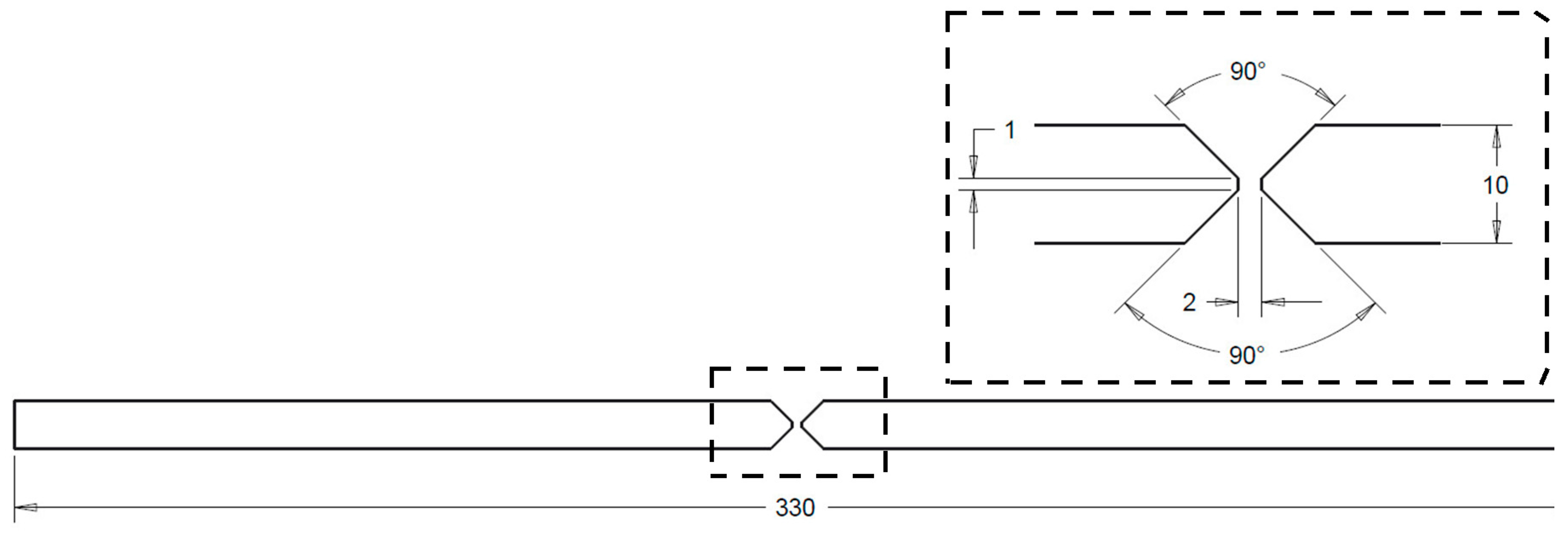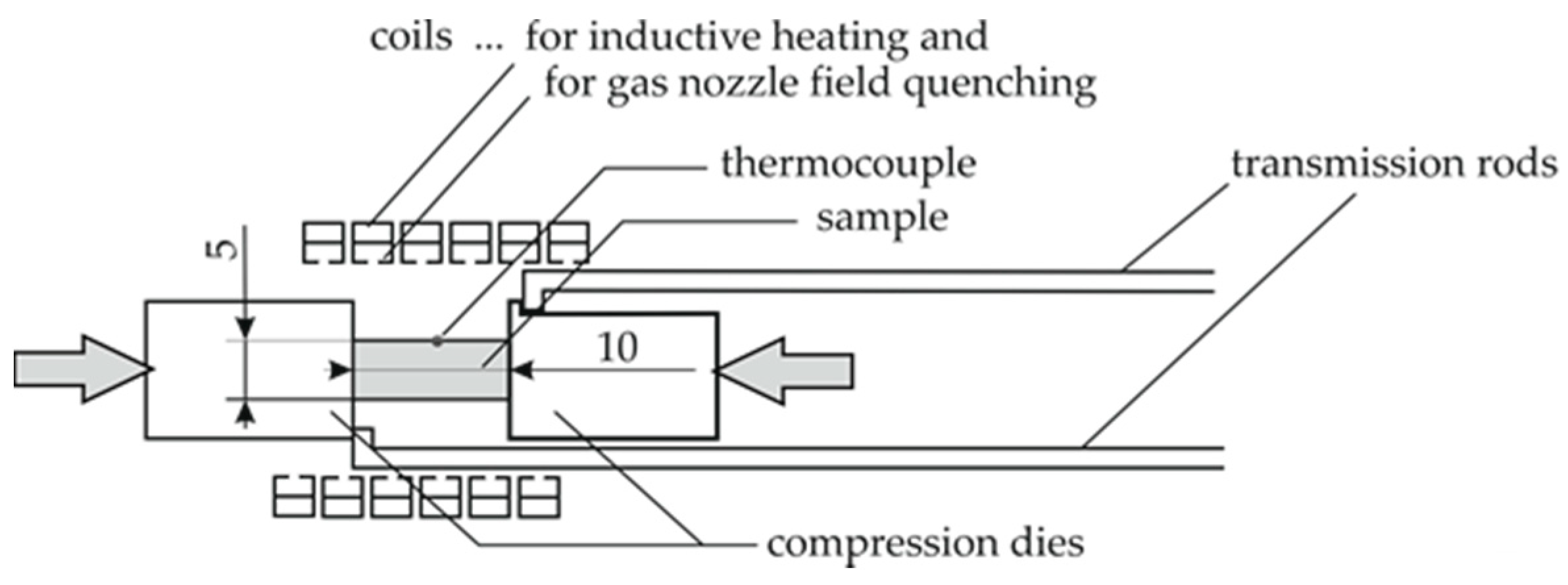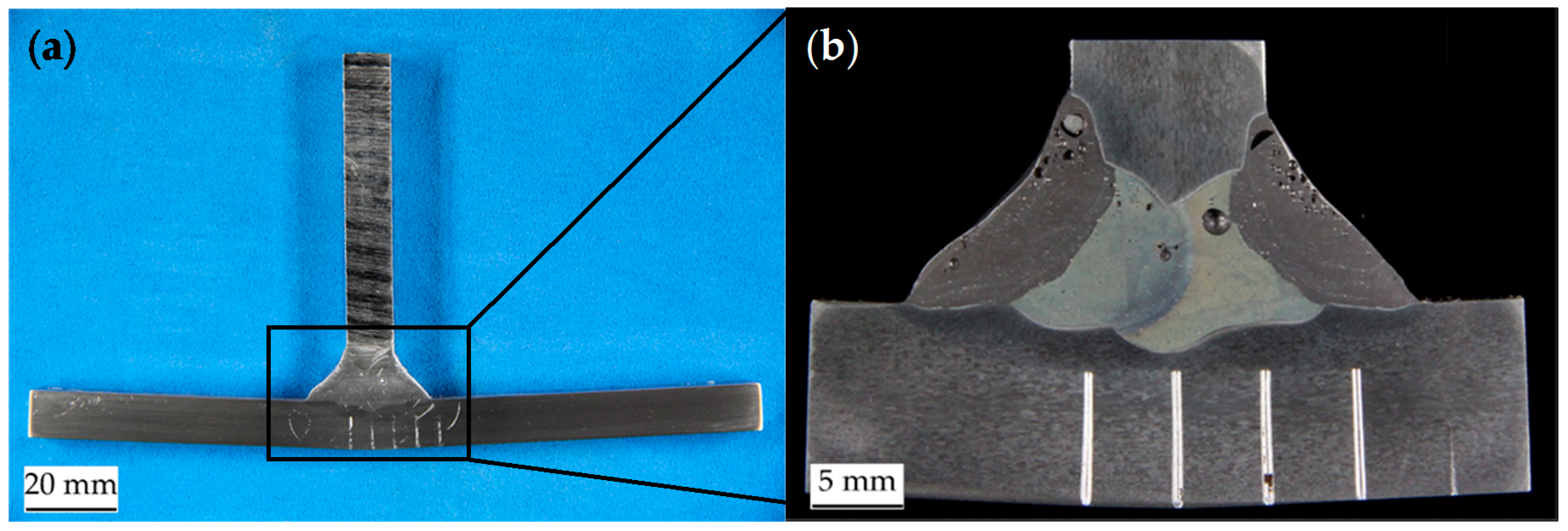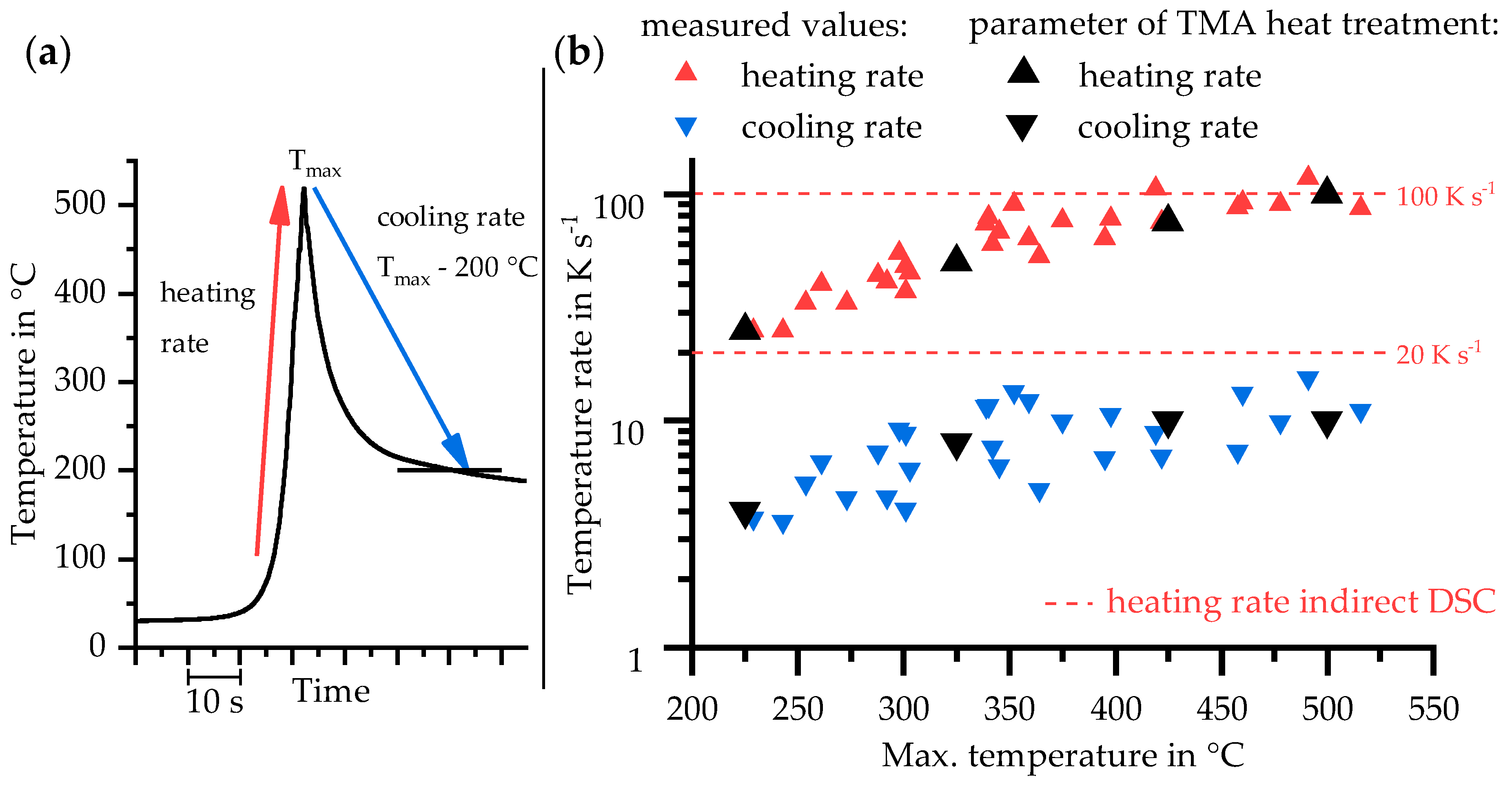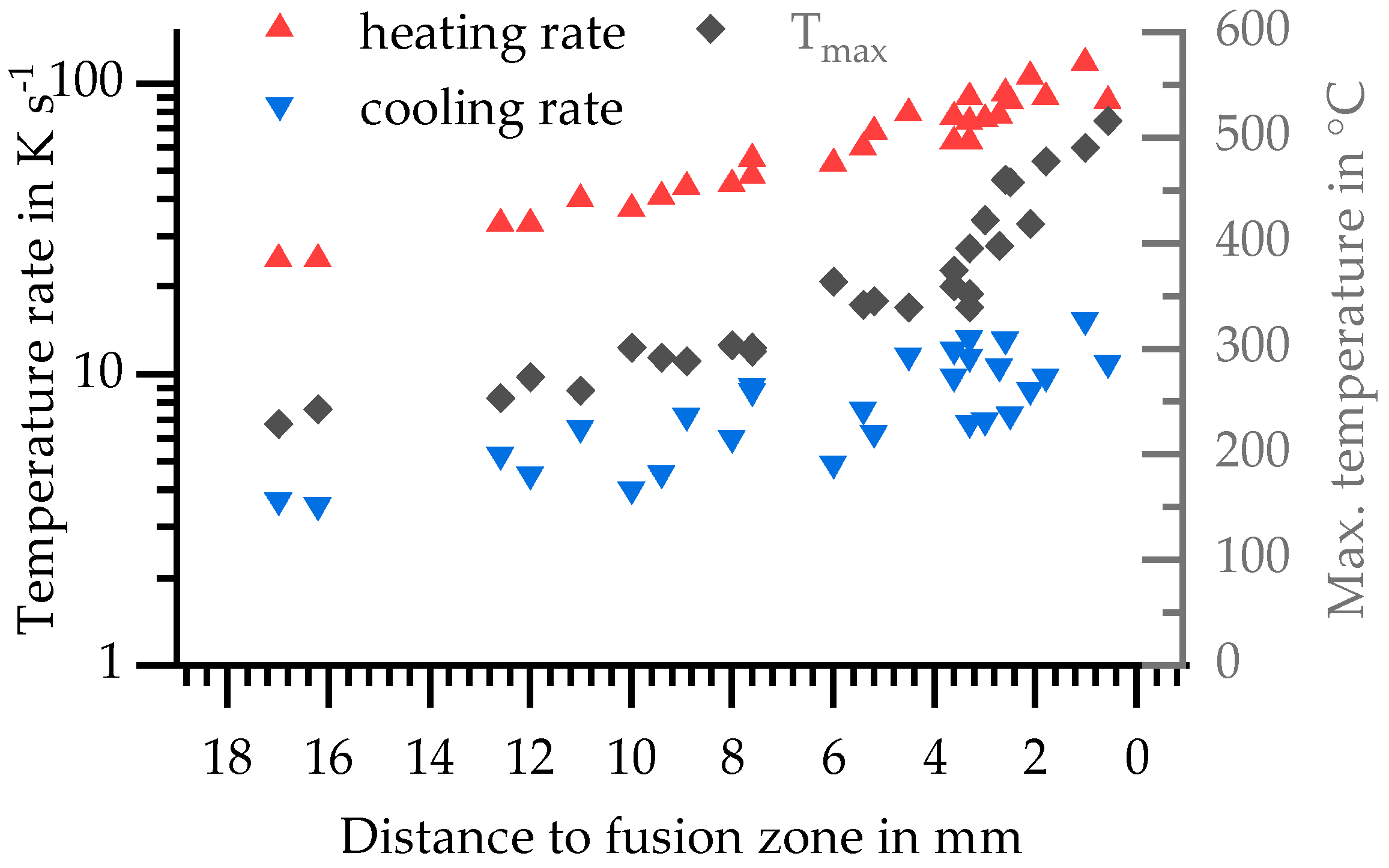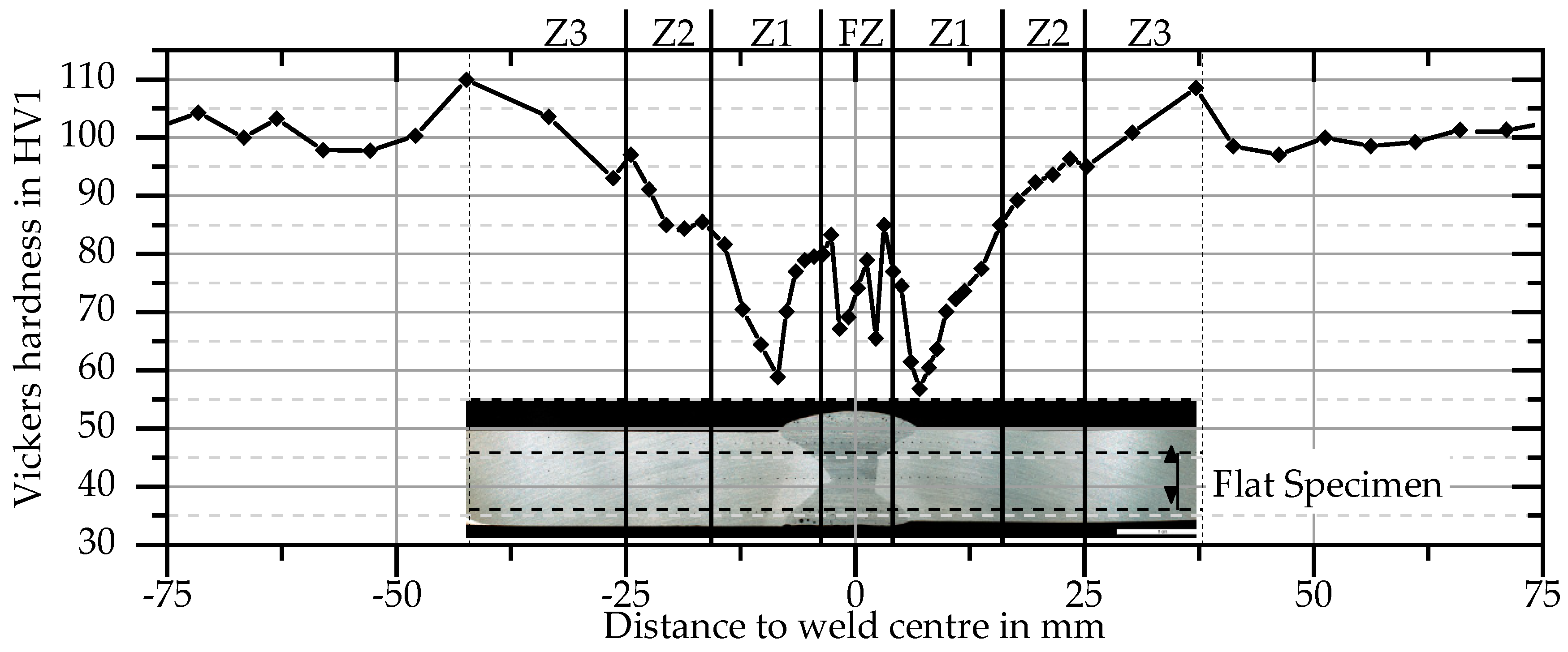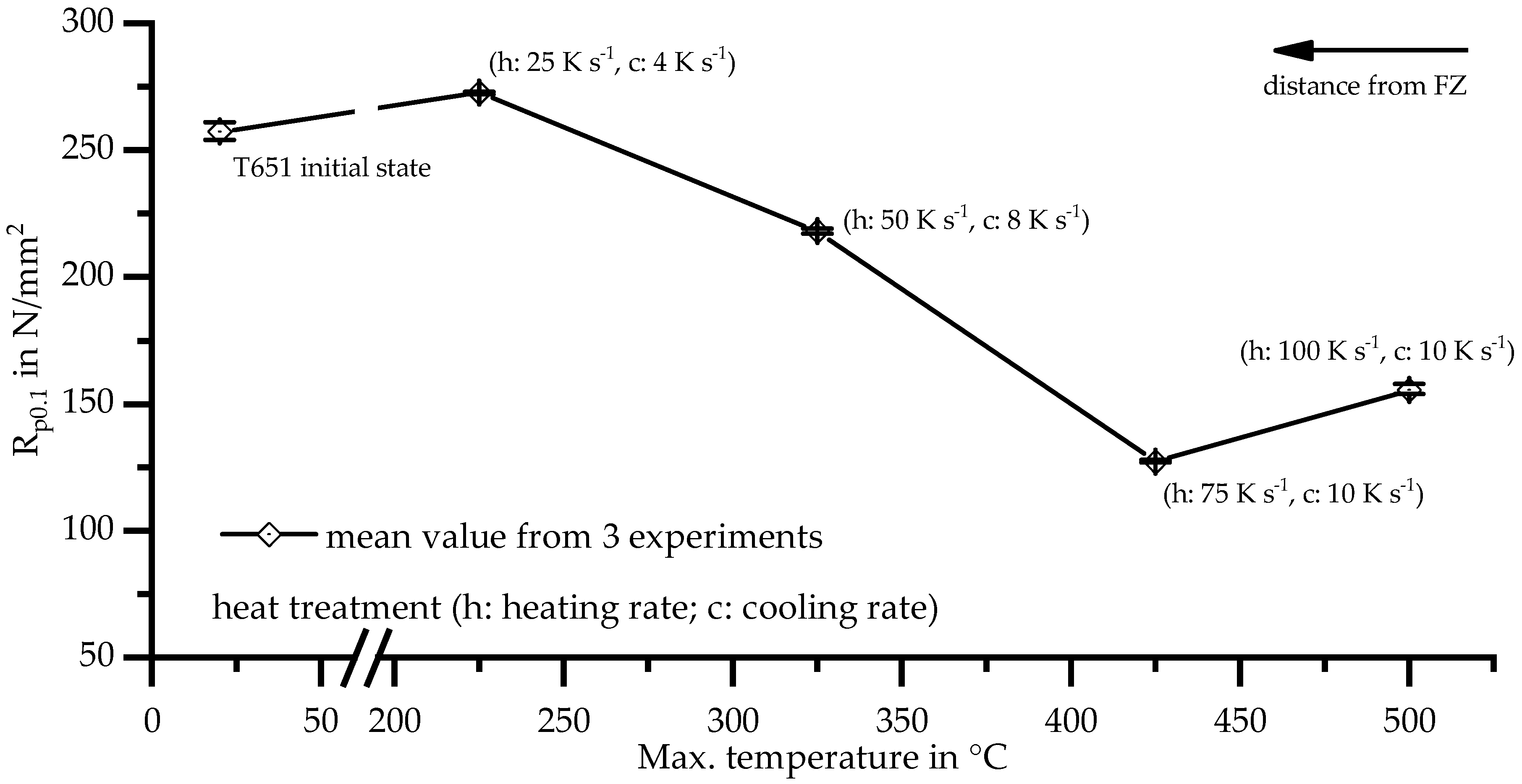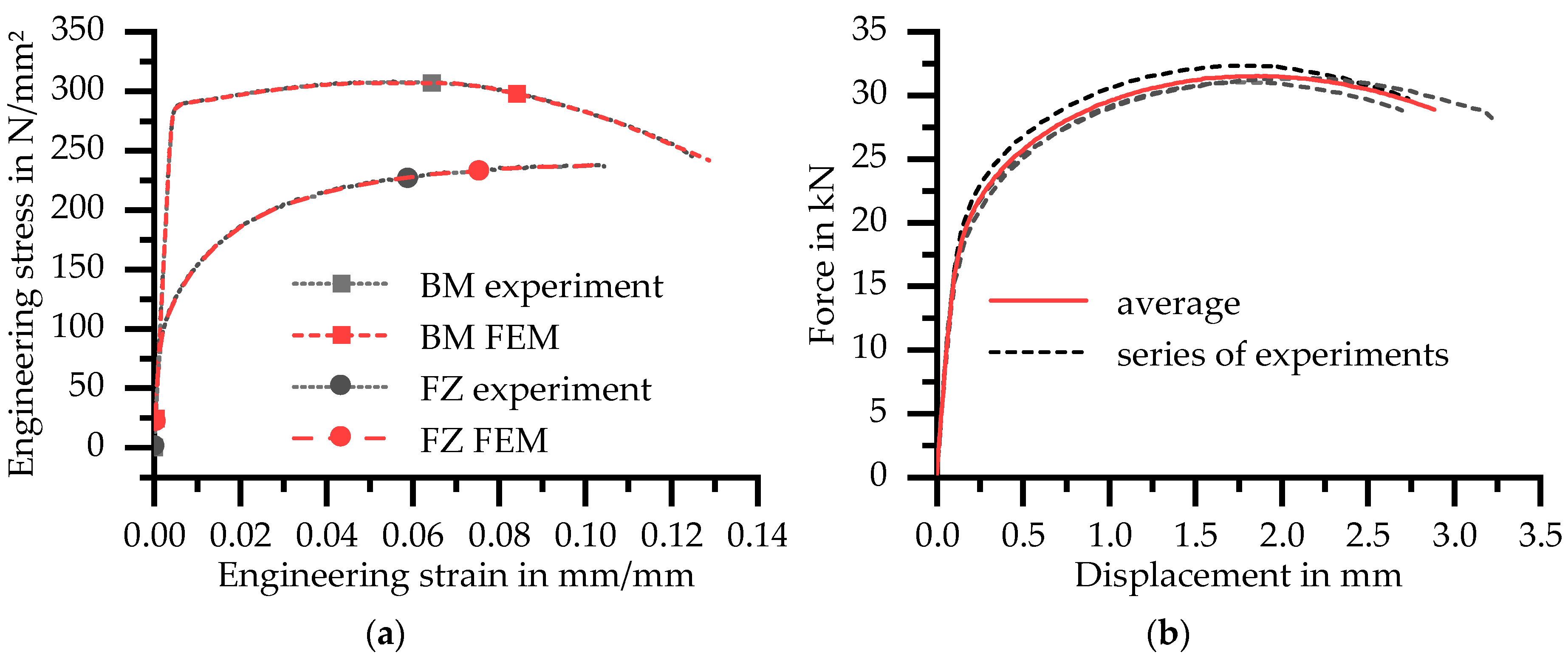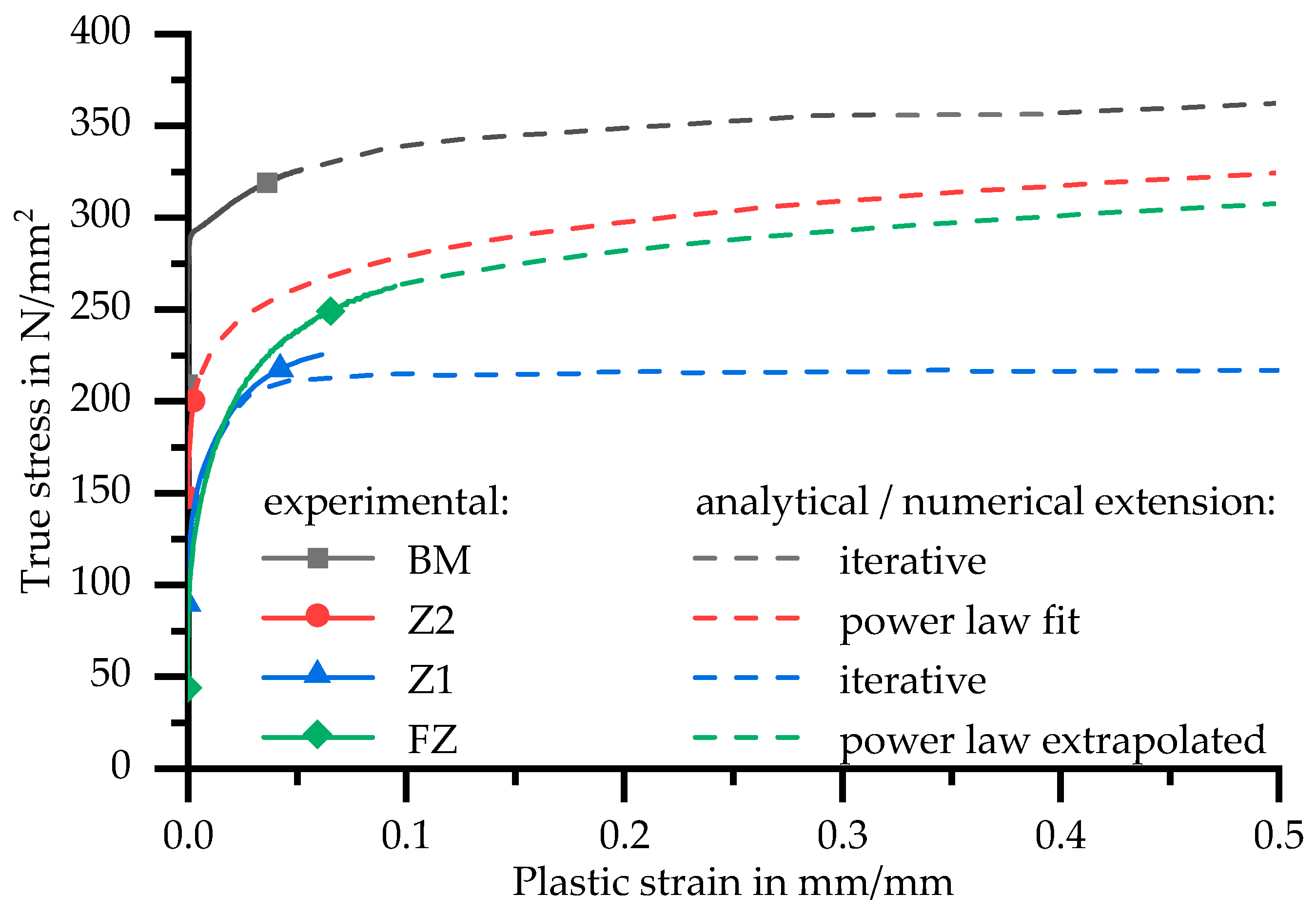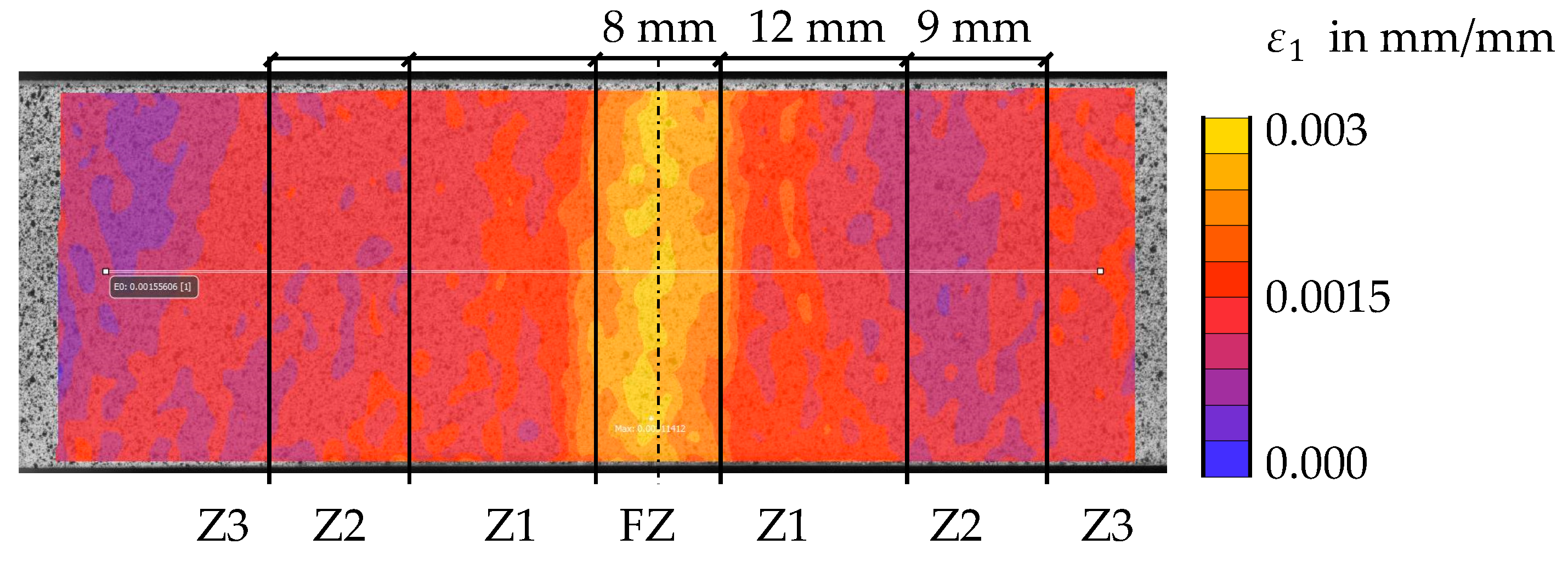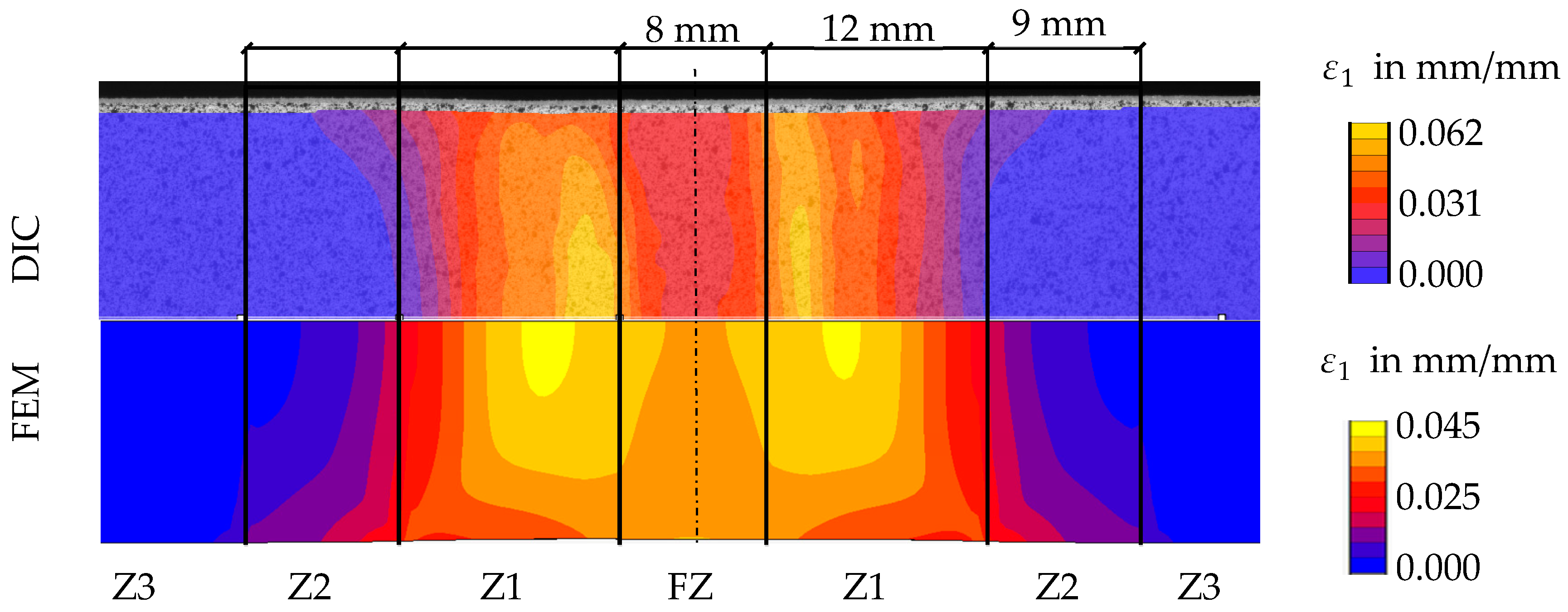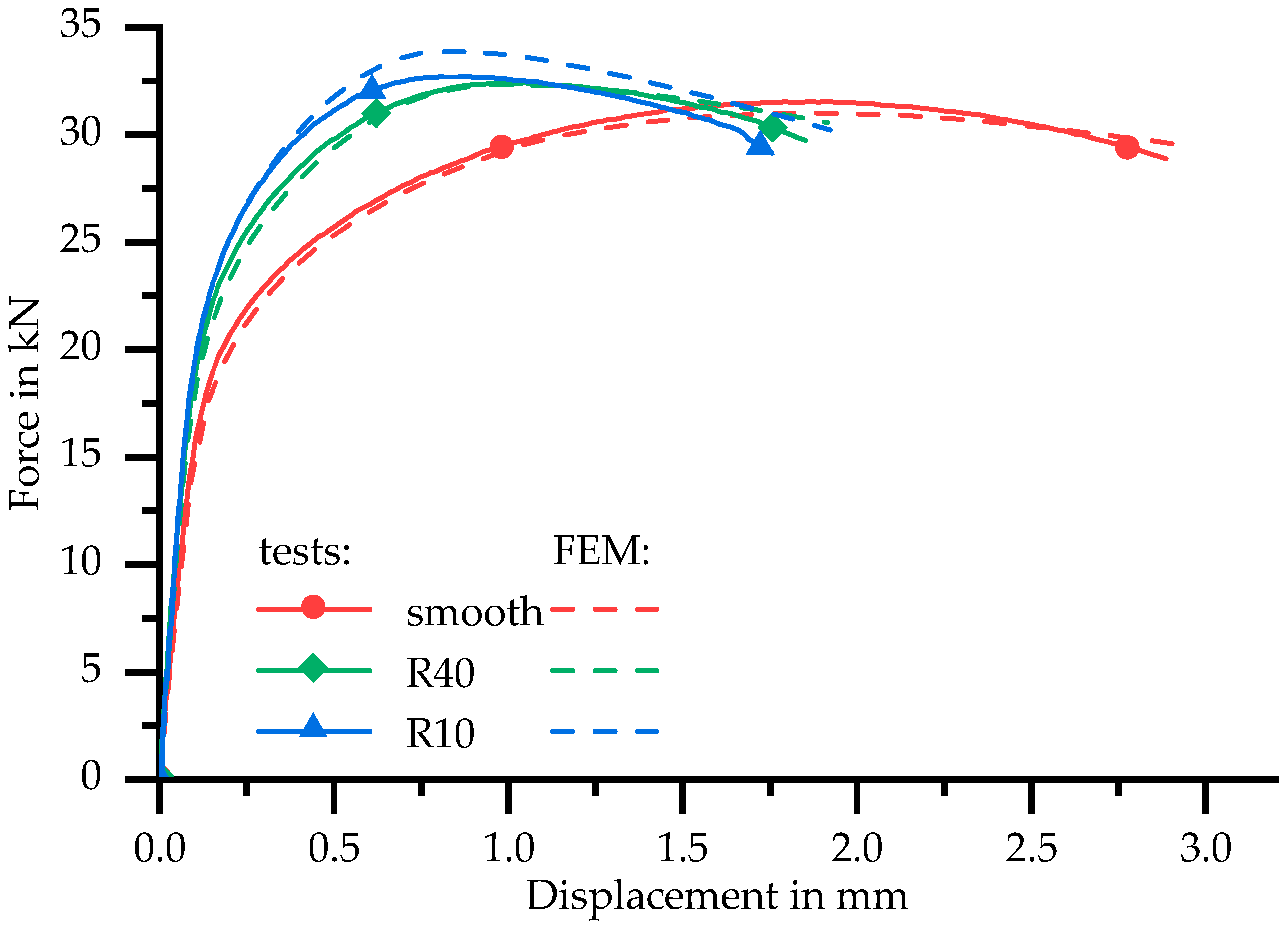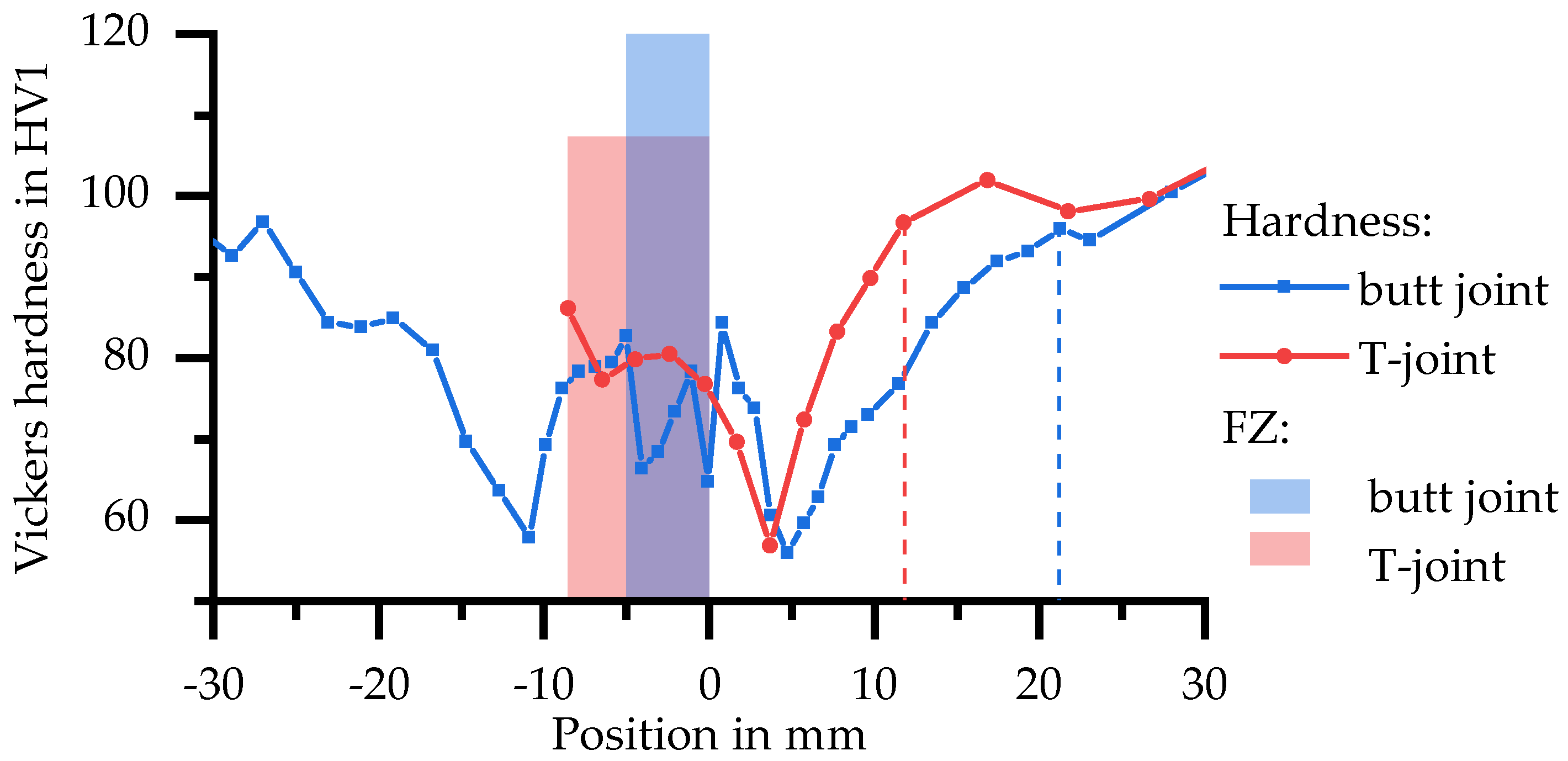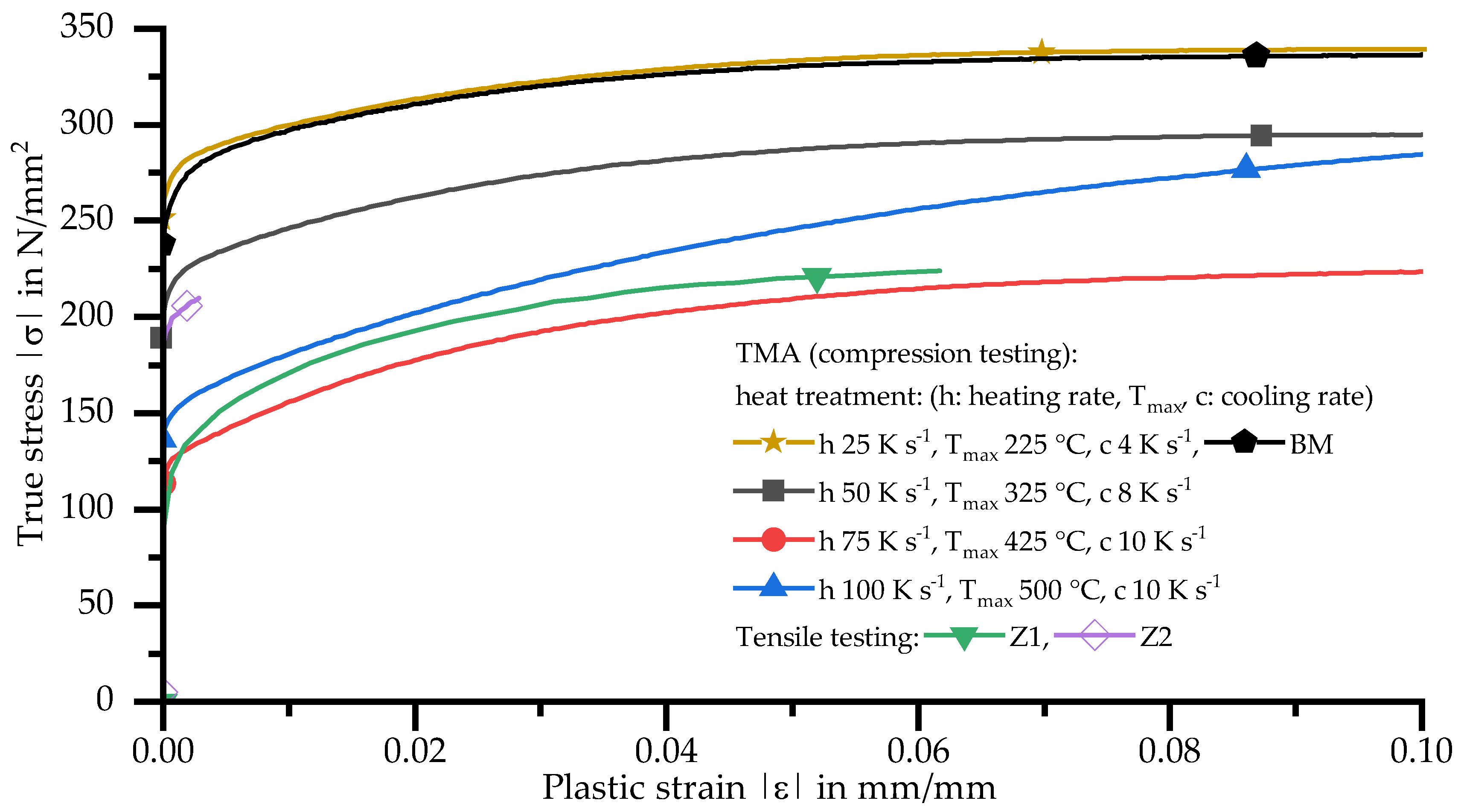3.1. Temperature–Time Course in Heat Affected Zone
The cross section of the welded joint, which was used for temperature measurements, is shown in
Figure 5 including thermocouple bores. The thermocouple wires were located at the end of the blind holes, so the distance between each weld bead and the points of temperature measurement was determined with these cross-section images.
A typical temperature–time course in HAZ during welding and its three analysed parameters (heating rate, T
max, and cooling rate) are shown in
Figure 6a. The heating in all recorded courses was nearly linear over a wide temperature range. The maximum temperature (T
max) was reached without a holding time and the cooling started immediately with a Newtonian course. Below 200 °C, the temperature decreases very slowly due to the relative small dimensions of joined plates, which heated up significantly. Therefore, only the cooling between T
max and 200 °C was used to calculate the mean cooling rate.
The analysed heating and cooling rates in the HAZ during welding are plotted against T
max in
Figure 6b. In principle, the heating and cooling rate increase as the maximum temperature rises, although a scattering of measured values occurs.
The three analysed parameters of temperature measurement revealed:
Linear heating rates: 25–118 K s−1
Maximum temperatures (Tmax): 229–516 °C
Averaged cooling rates between Tmax and 200 °C: 3.5–15 K s−1.
Because the maximum temperature correlates with distance from the fusion zone, these results are also plotted against the distance to weld bead in
Figure 7.
These results, temperature rates and corresponding maximum temperatures, retrace different positions in the HAZ and were selected as parameters for TMA in this study. They are marked with black symbols in
Figure 6b and given in
Table 5. The chosen heating rates of indirect DSC (20 K s
−1 and 100 K s
−1) are in the minimum and maximum range of these values.
3.2. Precipitation and Dissolution Behaviour of EN AW-6082 T651 in a Wide Dynamic Range
The excess heat capacity curves of heating the alloy EN AW-6082 with initial state T651 over a heating rate range from 0.01 K s
−1 to 5 K s
−1 up to 585 °C are plotted in
Figure 8. During heating of aluminium alloys, dissolution and precipitation reactions occur. Precipitations were measured as exothermic peaks and dissolution as endothermic peaks. These reactions are alternating and overlap each other. Thus, the DSC curves show only the resulting sum signal, and only the initial temperature of the first and the final temperature of the last reaction are true signals.
The DSC curve recorded by Osten et al. [
21] with another batch of EN AW-6082 with a 0.01 K s
−1 heating rate resembles the curve from this study with the same scanning rate. There are only slight differences in reaction behaviour at slow scanning rates, which can be explained by differences in chemical composition, but the sequence of reactions is the same. Therefore, their interpretation of the reaction sequence is used in this study. The reactions were labelled here with the same characters [
21].
The first peak B for the initial state T6 is induced by the dissolutions of GP-zones and β″, with β″ being the phase which effects the maximum strengths of Al-Mg-Si alloys [
13]. The peak d corresponds to either the precipitation of β″ or β′ depending on initial state [
13,
15]. For the initial state T651, there is probably only a precipitation of β′, because β″ is already dissolved in the previous reaction. The reactions which cause the peaks F and g belong to the dissolution of β′ and the precipitation of β (Mg
2Si). The dissolution of the remaining precipitations, especially β (Mg
2Si), is recorded as final peak H. At very slow heating rates, there is a reaction-free range following peak H, which indicates a complete dissolution of these particles [
21].
As the heating rates increase, there is a shift of reactions to higher temperatures, which also results in an incomplete dissolution with fast heating. Furthermore, the curves shift in the endothermic direction. However, it is unlikely that dissolution will increase at faster heating rates. Rather, it can be assumed that the shift is thus caused because precipitation reactions are significantly more suppressed than dissolution reactions.
Figure 9a displays the temperature–time course of the indirect DSC method. To maintain the condition at T
max and to prevent quench-induced precipitation, quenching is performed with maximum gas flow after the first heating. The average cooling rates
β of the Newtonian cooling course, which depended on the temperature interval considered, are listed in
Table 6.
Fröck et al. [
24] used the same batch of 6082 to investigate the influence of different solution conditions on the precipitation behaviour during subsequent cooling. For an incomplete solution state (after 540 °C for 1 min), the upper critical cooling rate (uCCR) of 100 K s
−1 was ascertained. The cooling rates of the heat treatment for indirect DSC are higher than this uCCR in temperature ranges above 100 °C. It can thus be assumed that no significant precipitation reactions took place during cooling and the state of the material reached at maximum temperature remains.
The reheating curves are shown in
Figure 9b,c. The reaction peaks are given the same characters as in
Figure 8. Low curvature is present in the curves, which can give reasons for slight quantitative differences between single curves. This is particularly apparent at higher temperatures, e.g., the peaks g and H, or the slope of reaction free zone are influenced by this remaining curvature. Nevertheless, the development of reactions is clearly visible. The reheating curves of the investigated heating rates 20 K s
−1 and 100 K s
−1 show no significant differences for the same T
max. Depending on T
max, there is a substantial development in the reheating curves for each heating rate. In conclusion, the reactions taking place in the HAZ are mainly dependent on T
max and are less dependent on the heating rate, at least in the investigated range.
The reheating curves from the initial state EN AW-6082 T651 to T
max of 275 °C are almost identical. That means no significant reactions take place until heating to this temperature. From T
max 300 °C an exothermic reaction starts (see arrows in
Figure 9b,c). These reaction peaks increase with a higher maximum temperature of first heating. During the first heating, existing precipitates are dissolved increasingly with rising temperature. A supersaturation occurs due to overcritical cooling, which causes the measured precipitation reactions during reheating. This dissolution reaction B
T651 during rapid heating is crucial for softening in the HAZ.
The reaction peaks determined by direct DSC and the dissolution reaction B
T651 determined by indirect DSC are plotted in temperature–time courses of investigated heating experiments, to create a continuous heating dissolution diagram for a wide range of heating rates, as shown in
Figure 10.
The temperatures of dissolution or precipitation reactions during heating of EN AW-6082 T651 within a range of 0.01 K s−1 to 100 K s−1 can be taken from this diagram. For heating of 20 K s−1 to 100 K s−1, investigated with indirect DSC, only the start of the dissolution reaction BT651 can be determined at temperatures between 275 °C and 300 °C.
3.3. Mechanical Properties of the HAZ
The results of hardness tests in
Figure 11 provide an overview of properties as a function of distance to the weld centre. At a distance from the weld centre of more than 50 mm a constant hardness of about 100 HV1 was measured in the base material 6082 T651. At about 40 mm, a maximum hardness of 110 HV1 is reached. One reason for the increase in hardness may be that the initial state T651 was slightly underaged and the welding heat causes artificial ageing at this point. With decreasing distance, the hardness decreases significantly to a minimum of about 60 HV1. The hardness increases in the direct vicinity of the FZ. Hardness of the FZ was about 70–80 HV1.
In
Figure 12, the results of TMA with parameters according to
Table 5 are plotted against T
max for the short term heat treatment. The yield strength has been measured after seven days of natural ageing. Compared with the initial state, there is a small increase for T
max 225 °C. From T
max 225 °C to 425 °C, the yield strength decreases by about half to less than 130 N/mm
2. For the highest investigated T
max of 500 °C the yield strength increases slightly.
Microstructure analyses (SEM and TEM) were performed by Fröck et al. [
24] with the same material after annealing at different maximum temperatures. During annealing, both complete and incomplete dissolution of secondary phase particles was achieved depending on the maximum temperature. As
Figure 9 shows, there will be an incomplete dissolution for fast heating rates. In consideration of the quasibinary phase diagram Al-Mg
2Si [
15], the same phases are expected after the TMA welding heat treatments as after solution annealing at 540 °C [
24].
Because maximum temperature correlates with distance to the FZ, the course of the yield strength (
Figure 12) depending on maximum temperature is similar to the hardness profile (
Figure 11).
Regarding DSC and TMA, the HAZ of 6082 T6 can be divided in four areas.
- A.
Above 425 °C, solution annealing takes place. Rapid quenching near the FZ causes a supersaturated solid solution with potential for age hardening. Yield strength increases again after natural aging.
- B.
From 275 °C to 425 °C, β″ precipitates increasingly dissolve and yield strength decreases.
- C.
Weak precipitation of β″ happens at a temperature range of 225 °C, which leads to a slight increase in hardness and strength, but is hardly detected with DSC.
- D.
At a distance of more than 50 mm (below a certain Tmax), the T6 state consisting of β″ precipitates remains nearly unchanged. Hardness is not affected.
3.4. Flow Curves in a Welded Joint
For the calculation of the flow curve of the base material and the fusion zone the engineering stress–strain curves determined from tensile tests on separate round specimens have been used. The mechanical properties of the fusion zone material were also determined from these tensile tests and are presented in
Table 7. The chemical composition of the FZ according
Table 1 appears in the range of cast aluminium alloys, which also roughly applies for its mechanical properties.
Whereas the base material shows ductile failure with necking after reaching the ultimate tensile strength, the fusion zone material fails without any noticeable necking (see
Figure 13a). Therefore, the combined analytical and numerical approach described in Chapter 2.6 was used to calculate the flow curve of the base material. Numerical iterations were not necessary for the fusion zone material, since no necking and therefore no multiaxial stress state was present. The flow curve of the fusion zone was simply calculated by Equations (2)–(4). An extrapolation with Equation (6) extends the curve to a larger range of strains. To validate the obtained flow curves, a comparison between calculated and measured technical stress–strain curves is also shown in
Figure 13a. No differences between the measured and simulated curves are visible.
Whereas all tests with the base and fusion zone material showed very good repeatability, the global force–displacement curves of the three tested welded flat specimens showed slight differences (see
Figure 13b). It is assumed that the differences occur because of irregularities in the weld seam in length direction as well as due to specimen manufacturing from slightly different areas over the sheet thickness. To overcome the differences between curves, one average curve was used for comparison reasons with numerical simulations.
In addition to the global force–displacement curve, local force–displacement curves for the zones Z1 and Z2 were also determined by using the DIC. The respective lengths and positions of the material zones were derived from hardness measurements as shown in
Figure 11. Z1 is the area between 4 mm and 16 mm distance to the centre of the fusion zone. This is the area in which fracture occurs during tensile tests. Z2 ends at 25 mm distance to the centre of the fusion zone when the hardness values increase to about 95% of the base material (i.e., about 95 HV1). For distances to the fusion zone larger than 25 mm (Z3), the properties of the unaffected base material are nearly reached.
For this arrangement, the experimental force–displacement data for Z2 only allows a calculation of the flow curve until about 0.3% plastic strain, because failure and strain localisation occurred in Z1. The curve of Z2 is extended to higher strains by fitting a power law according to Equation (5). The flow curve of Z1 is obtained afterwards through iteration with numerical simulations. In contrast to the base material, it was not possible to use Equations (2)–(4) until necking occurs (see
Figure 14).
Due to the inhomogeneity of the HAZ, uniform elongation cannot be assumed until the maximum force is reached. Therefore, the experimental data were used as initial values for the numeric iteration only as long as agreement was maintained between the measured and calculated force–displacement curves.
3.5. Validation of Obtained Flow Curves in the HAZ
The results of the tensile tests with butt welded flat specimen are here described in more detail. To validate the calculated curves, the strain distribution in the experiment (DIC) can be compared with the numerical results. Therefore, the maximum principal strain
was calculated in the DIC software at the specimen’s surface. First,
Figure 15 shows that no uniform elongation of the specimen is present even at low global displacements (maximum strain of 0.3%). Whereas the hardness measurements (see
Figure 11) suggest the highest strain in Z1 next to the fusion zone, the fusion zone material dominates the deformation of the specimen at low strains. The behaviour of the flow curves (
Figure 14) of the two zones explains this phenomenon: at low strains, the flow stress of the fusion zone material is less than the flow stress of Z1. A certain amount of strain hardening needs to occur for Z1 to dominate the deformation behaviour of the specimen.
The top of
Figure 16 shows the measured strain distribution of the specimen at 1.3 mm global displacement. In contrast to the strain distribution at low displacements, here, the highest strains occur almost symmetrically next to the fusion zone in Z1. For comparison, the bottom of
Figure 16 shows the maximum principal strains calculated by the finite element (FE) simulation at the same displacement.
At first glance, the strain distribution shows good agreement between model and experiment. In both cases, the maximum strain is located in Z1. Whereas there are still noticeable strains in the fusion zone, the strain decreases within a few millimetres in Z2 to almost negligible strains in Z3. Since Z3 and Z2 deform less than Z1, the deformation of Z1 is constrained in the width direction. This constraint causes higher strains in Z2 at the edge of the specimen than in the middle. The constraining effect on the different material deformations becomes stronger in the simulation than in the experiment, because the FE model has no continuous change in material properties but rather an explicit change at the end of each material zone.
Another difference becomes visible by comparing the maximum strain values. The measured maximum strain is higher than in the numerical simulation and located closer to the fusion zone. It has to be pointed out that differences in maximum strain occur even though the measured and simulated force–displacement curves of the whole specimen are almost identical (see
Figure 17). This is possible because the flow curve of Z1 averages a quite large area of the HAZ compared to high changes in hardness and the presumed mechanical properties in this zone. Since for example the lowest yield stress is averaged to a higher value, a smaller strain peak will be calculated.
To investigate the behaviour of the HAZ in different multiaxial stress states and to validate the obtained flow curves in more detail, tensile tests and numerical simulations of notched specimens were conducted.
Figure 17 shows a comparison of three different specimen shapes: smooth, large notch radius (40 mm) and small notch radius (10 mm) with equal nominal cross sections.
As it is well known, a notch will increase the maximum force: the smaller the notch radius, the higher the maximum force. The experimental results confirm this fact. However, the increase of the maximum force is small. This indicates that the inhomogeneity of the material dominates over the geometric effect due to the notch. The increase of maximum force is calculated by the FE simulations as well. However, the simulated and measured force–displacement curves of the specimen with large notch radii have good agreement, while the simulation overestimates the maximum force of the sharp notched specimen. Due to the material properties averaged in Z1, expressed by the flow curve, a larger force is required in the finite element simulation in order to map the local strain concentration in the notch root.
3.6. Correlation between Results of Tensile Tests and TMA of HAZ
When comparing the results of different methods, the type of joint used for temperature measurement (T-joint) and tensile test specimen (butt joint) must be considered. Whereas in a butt weld the heat can only be dissipated in two directions, the T-joints consists of three segments. Higher Tmax as a function of distance and lower cooling rates can therefore be expected on the butt weld.
Hardness profiles (see
Figure 18) of both welds were recorded in order to compare the welds and in particular the size of the HAZs with each other.
For the T-joint, the values of the FZ and the vertical plate are shown. In HAZ the hardness first decreases to a minimum, which is at a distance to FZ of 4 mm in the T-joint and at 5–6 mm in the butt joint. In further course the hardness increases until the initial value of about 100 HV1 is reached at 12 mm (T-joint) and 21 mm distance (butt joint) respectively. The courses of hardness are the same and the locations of, e.g., the minimum or initial hardness, match, considering the geometrically changed distribution of Tmax.
Flow curves of the HAZ determined with tensile test and TMA can therefore be compared as seen in
Figure 19.
The curve of Z1 is enveloped by the retraced HAZ with Tmax 500 °C and 425 °C for low plastic strains. The experimentally determined flow curve of Z2 is only available up to the maximum stress of Z1, but it can be assumed that it follows the curve with Tmax 325 °C. These results are in good agreement regardless of the different heat input in tensile and TMA samples. Whereas the tensile tests were carried out with specimens heated three times up to different maximum temperatures (three weld beads), the TMA specimens were subjected to a single, precisely defined short-term heat treatment.
The lowest mechanical properties are obtained by TMA with T
max 425 °C. By evaluating tensile tests in Z1 with the combined numerical and analytical approach described previously, the low mechanical properties as in the TMA cannot be determined due to the averaging in Z1. Averaging over the area of Z2 leads to a curve similar to the TMA flow curve with T
max 325 °C, even though no significant difference to the BM is expected at the end of Z2. As
Figure 12 shows, the short-term heat treatment with T
max 225 °C results in maximum strength just above that of the BM.
It becomes visible that a combined approach with tensile tests, DIC and numerical simulations and DSC and TMA following temperature profiles during welding can lead to an improved description of material behaviour in different areas of a weld for a specific welding process and geometry. With knowledge of the maximum temperatures depending on the distance to the FZ, phase transformations obtained by DSC and material properties obtained in a TMA can therefore deepen understanding of the microstructural changes in the HAZ and refine numerical structure–mechanical simulations of welded components.
